2008 MERCEDES-BENZ SL ROADSTER lights
[x] Cancel search: lightsPage 6 of 317

3A
ABC see Active Body Control
ABC (Active Bod yControl)
Display message ....................... 204, 205
ABS (Anti-lock Braking System) .....53
Display message .............. 205
Warning lamp ............. 233, 234
Acceleration
Technical data ................ 291
Accident
Notes ....................... 241
Active Body Control (ABC) ........139
Active light system see Ligh tsystem (active)
Active Light System
Display message .............. 220
Active service system
see Service interva ldisplay
Adaptive brake lamps .............54
Airbag Activation ..................... 41
Control unit ................... 41
Driver's ....................... 44
Front ........................ 44
Front passenger ................ 44
Head/thorax airbags ............45PASSENGER AIRB
AGOFF warning
lamp ....................... 231
System ....................... 43
Ai rc onditioning
Activating/deactivating .........147
Activating/deactivating air-recir-
culation mode ................ 152
Air-recirculation mode with con-
venience opening/closing feature .152
Automatic airc onditioning.......145
Controlling automatically ........148
Cooling with aird ehumidification..147
Demisting the windscreen .......151
Misted-up windows ............151
Rea rwindow heating ........... 152
Setting the aird istribution.......150
Setting the airflow .............151
Setting the airv ents............ 149
Setting the temperature .........148
Switching the residua lheatfunc-
tion on/off ................... 153
see Climate control
AIRSCARF neck-level heating .......76
Antifreez econcentration .........306
Anti-loc kbraking system
see ABS
Anti-theft alarm system
see ATA
Anti-theft systems ................ 59
Ashtray ........................ 165ASSYST
see Service interva ldisplay
ASSYST service interval display ...193
ATA (anti-theft alarm system) ......59
Switching off the alarm ..........60
Audibl ewarning signal ........... 240
AUTO lights Display message .............. 220
Automatic air conditioning
Malfunction indicator lamp ......231
Automatic car wash .............195
Automatic transmission Changing gea ryoursel f.......... 99
Display in the speedomete r.......99
Driving tip s.................. .101
Emergency running mode .......246
Malfunction .................. 246
One-touch gearshifting ...........99
Program selector button ........100
Selector leve rpositions .......... 99
Shift ranges .................. 100
Axl eload, maximum permissible ...299 B
BAS (Brake Assist) ................ 54
Basic display (on-board computer) .110
Battery Changing (key )................ 259
Changing (KEYLESS GO key) .....259 Index
230_AKB; 5; 4, en-GB
bjanott,
Version: 2.9.6
2008-04-08T15:09:54+02:00
-Seite 3 Dateiname: 6515_3089_02_buchblock.pdf; preflight
Page 8 of 317
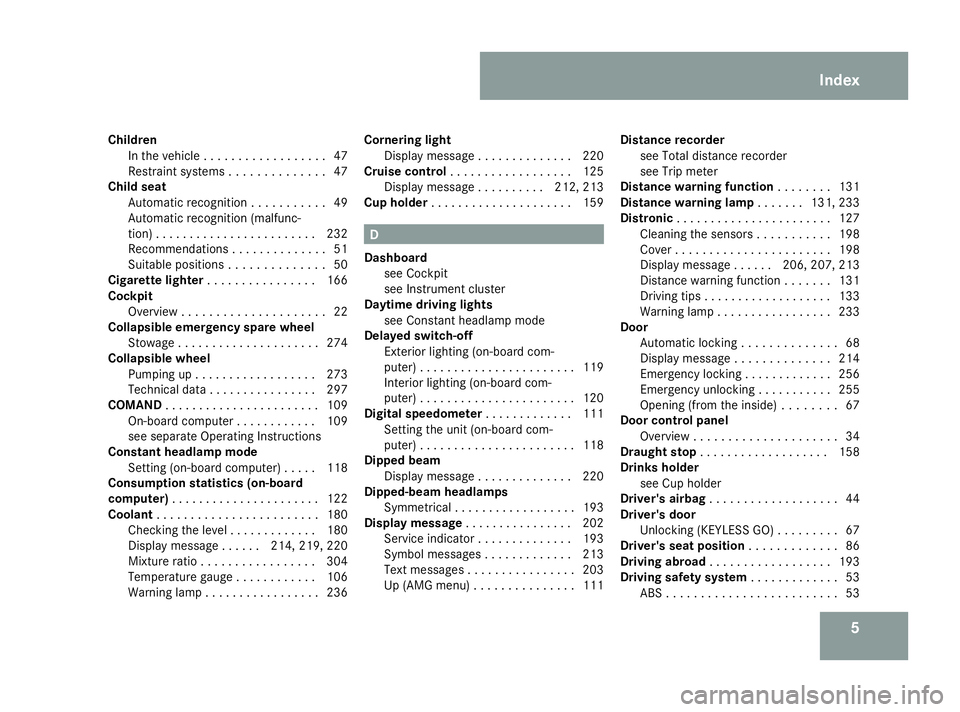
5
Children
In th evehicle .................. 47
Restrai ntsystems .............. 47
Chil dseat
Automatic recognition ...........49
Automatic recognition (malfunc-
tion) ........................ 232
Recommendations ..............51
Suitable positions .............. 50
Ciga rettel ighter ................ 166
Cockpit Overview ..................... 22
Collapsible emergency spare wheel
Stowage ..................... 274
Collapsibl ewheel
Pumping up .................. 273
Technical data ................ 297
COMAND ....................... 109
On-board computer ............109
see separate Operating Instructions
Constant headlamp mode
Setting (on-board computer) .....118
Consumptio nstatistic s(on -board
computer) ...................... 122
Coolant ........................ 180
Checking the leve l.............180
Display message ......214, 219, 220
Mixture ratio ................. 304
Temperature gauge ............106
Warning lamp ................. 236Cornerin
glight
Display message .............. 220
Cruis econtrol .................. 125
Display message ..........212, 213
Cup holder ..................... 159 D
Dashboard see Cockpit
see Instrument cluster
Daytime drivin glights
see Constant headlamp mode
Delaye dswitch-off
Exterior lighting (on-board com-
puter) ....................... 119
Interior lighting (on-board com-
puter) ....................... 120
Digital speedometer .............111
Setting the unit (on-board com-
puter) ....................... 118
Dipped beam
Display message .............. 220
Dipped-beam headlamps
Symmetrical .................. 193
Display message ................ 202
Service indicator .............. 193
Symbo lmessages ............. 213
Text messages ................ 203
Up (AMG menu) ............... 111Distanc
erecorder
see Total distance recorder
see Trip meter
Distanc ewarning function ........131
Distanc ewarning lamp .......131, 233
Distronic ....................... 127
Cleaning the sensors ...........198
Cove r....................... 198
Display message ......206, 207, 213
Distance warning function .......131
Driving tips ................... 133
Warning lamp ................. 233
Door
Automatic locking .............. 68
Display message .............. 214
Emergency locking .............256
Emergency unlocking ...........255
Opening (from the inside) ........67
Door control panel
Overview ..................... 34
Draught stop ................... 158
Drinks holder see Cuph older
Driver's airbag ................... 44
Driver's door Unlocking (K EYLESS GO) ......... 67
Driver's seat position .............86
Drivin gabroad .................. 193
Driving safety system .............53
ABS ......................... 53 Index
230_AKB; 5; 4, en-GB
bjanott,
Version: 2.9.6 2008-04-08T15:09:54+02:00-Seite 5 Dateiname: 6515_3089_02_buchblock.pdf; preflight
Page 11 of 317
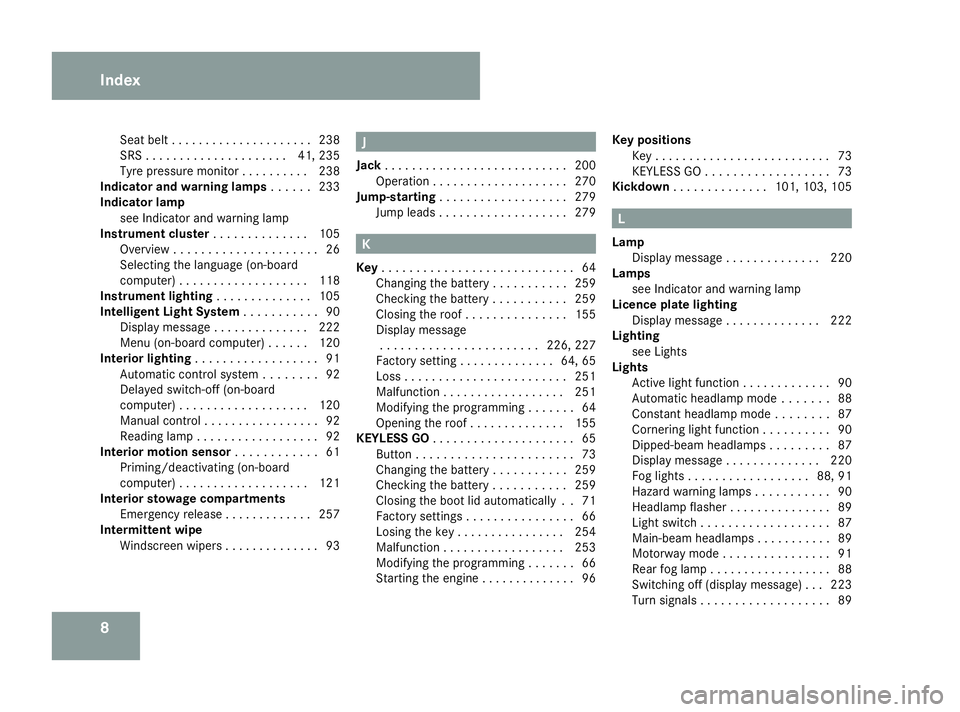
8Sea
tbelt.....................2 38
SRS ..................... 41, 235
Tyr ep ressure monitor ..........238
Indicator and warning lamps ......233
Indicator lamp see Indicator and warning lamp
Instrument cluster ..............105
Overview ..................... 26
Selecting the languag e(on-board
computer) ................... 118
Instrument lighting ..............105
Intelligen tLight System ........... 90
Display message .............. 222
Menu (on-board computer) ......120
Interior lighting .................. 91
Automatic control system........ 92
Delayed switch-off (on-board
computer) ................... 120
Manual control ................. 92
Reading lamp .................. 92
Interior mo tion sensor ............ 61
Priming/deactivating (on-board
computer) ...................1 21
Interior stowage compartments
Emergency release .............257
Intermittent wipe
Windscreen wipers ..............93 J
Jack ........................... 200
Operation .................... 270
Jump-starting ................... 279
Jump leads ................... 279 K
Key ............................ 64
Changing the battery ...........259
Checking the battery ...........259
Closing the roof ............... 155
Display message ....................... 226, 227
Factory setting .............. 64, 65
Loss ........................ 251
Malfunction .................. 251
Modifying the programming .......64
Openin gthe roof .............. 155
KEYLESS GO ..................... 65
Button ....................... 73
Changing the battery ...........259
Checking the battery ...........259
Closing the boot lid automatically ..71
Factory settings ................ 66
Losing the key ................ 254
Malfunction .................. 253
Modifying the programming .......66
Starting the engine ..............96Keyp
ositions
Key .......................... 73
KEYLESS GO .................. 73
Kickdown .............. 101, 103, 105 L
Lamp Display message .............. 220
Lamps
see Indicator and warning lamp
Licenc eplate lighting
Display message .............. 222
Lighting
see Lights
Lights
Active light function .............90
Automatic headlamp mode .......88
Constant headlamp mod e........87
Corneri nglight function .......... 90
Dipped-bea mheadlam ps......... 87
Display message .............. 220
Fog lights .................. 88, 91
Hazard warning lamps ...........90
Headlamp flasher ............... 89
Light switch ................... 87
Main-beam headlam ps........... 89
Motorway mode ................ 91
Rear fo glamp .................. 88
Switching off (displaym essage)...223
Turn signals ................... 89Index
230_AKB; 5; 4, en-GB
bjanott,
Version: 2.9.6 2008-04-08T15:09:54+02:00-Seite 8 Dateiname: 6515_3089_02_buchblock.pdf; preflight
Page 24 of 317

Exterior view
21Function Page
1 Boot
Opening and closing 68
Vehicl
etoolkit 200
Spare wheel* 200,
2 Rear window heating
152
3 Fuel fille
rflap 175
Fuel requirements 175
4 Doors
Opening and closing 64
Opening/closing in an
emergency
255
5 Exterio
rmirrors 80
6 Roof
Opening and closing 154
Draught stop 158
Boot separator 156 Function Page
Roller sunblin
dfor th eglass
roof* 159
7 Demisting th
ewindscreen 151
Cleaning th
ewindows 196
8 Windscree
nwipers 92
9 Opening th
ebonnet 176
Engin
eoil 178
Coolant 180
Vehicl
ebattery 276
a Fron
tlights 261
b Headlamp cleanin
gsystem 90
c Fitting th
efront towin geye 280
d Wheels and tyres
182
Tyre pressur
eloss warning
system 185 Function Page
Checkin
gthe tyrep ressure
electronically* 186
Flat tyre 266
e Rear lights
263
f Fitting th
erear towin geye 280At
ag lance
*o ptional
230_AKB
;5;4,en-GB
bjanott ,V ersion: 2.9.6
2008-04-08T15:09:54+02:00
-Seite 21 Dateiname: 6515_3089_02_buchblock.pdf; preflight
Page 30 of 317
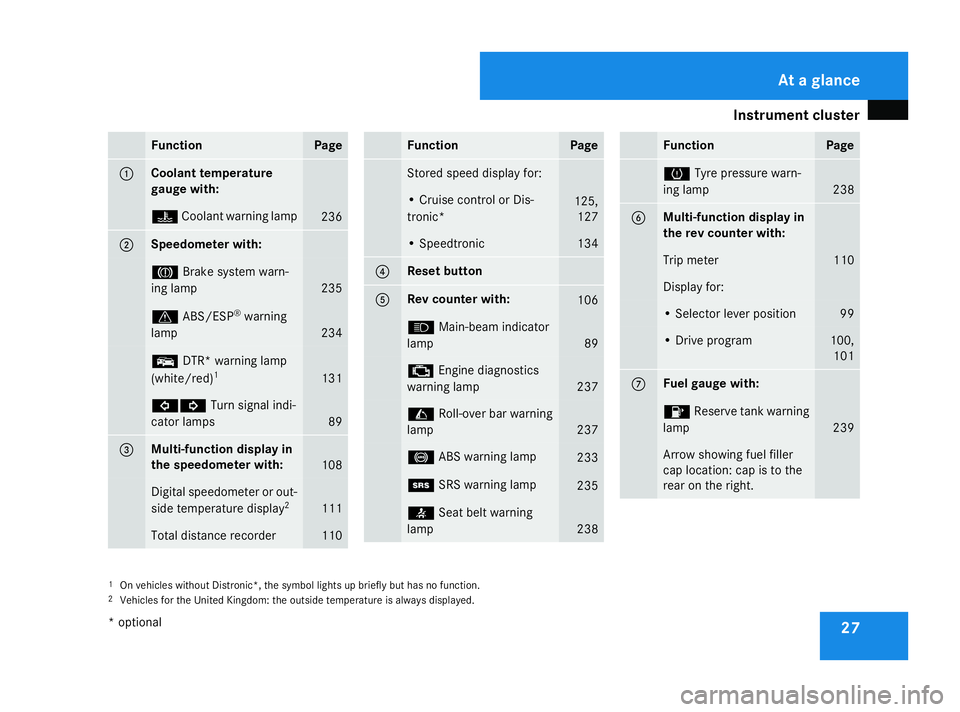
Instrument cluster
27Function Page
1 Coolant temperature
gauge with:
D
Coolant warnin glamp 236
2 Speedometer with:
3
Brake system warn-
in gl amp 235
v
ABS/ESP ®
warning
lamp 234
E
DTR* warnin glamp
(white/red) 1 131
LK
Turnsignal indi-
cator lamps 89
3 Multi-function display in
th
es peedometer with: 108
Digital speedometer or out-
side temperature display
2 111
Total distanc
erecorder 110 Function Page
Store
dspeed display for: •C
ruisecontro lorD is-
tronic* 125,
127 •S
peedtronic 134
4 Reset button
5 Rev counte
rwith: 106
A
Main-beam indicator
lamp 89
±
Enginediagnostics
warnin glamp 237
C
Roll-ove rbar warning
lamp 237
-
ABSw arnin glamp 233
1
SRS warnin glamp 235
<
Seat belt warning
lamp 238 Function Page
X
Tyre pressur ewarn-
in gl amp 238
6 Multi-function display in
th
er ev counte rwith: Tri
pm eter 110
Displa
yfor: •S
electo rlever position 99
•D
rive program 100,
101 7 Fuel gauge with:
4
Reserv etankw arning
lamp 239
Arrow showin
gfuelfiller
cap location :cap is to the
rear on th eright. 1
On vehicles without Distronic* ,the symbol lights up briefl ybut has no function.
2 Vehicles fo rthe United Kingdom: th eoutsid etem perature is always displayed. At
ag lance
*o ptional
230_AKB; 5; 4, en-GB
bjanott
,V ersion: 2.9.6
2008-04-08T15:09:54+02:00
-Seite 27 Dateiname: 6515_3089_02_buchblock.pdf; preflight
Page 32 of 317
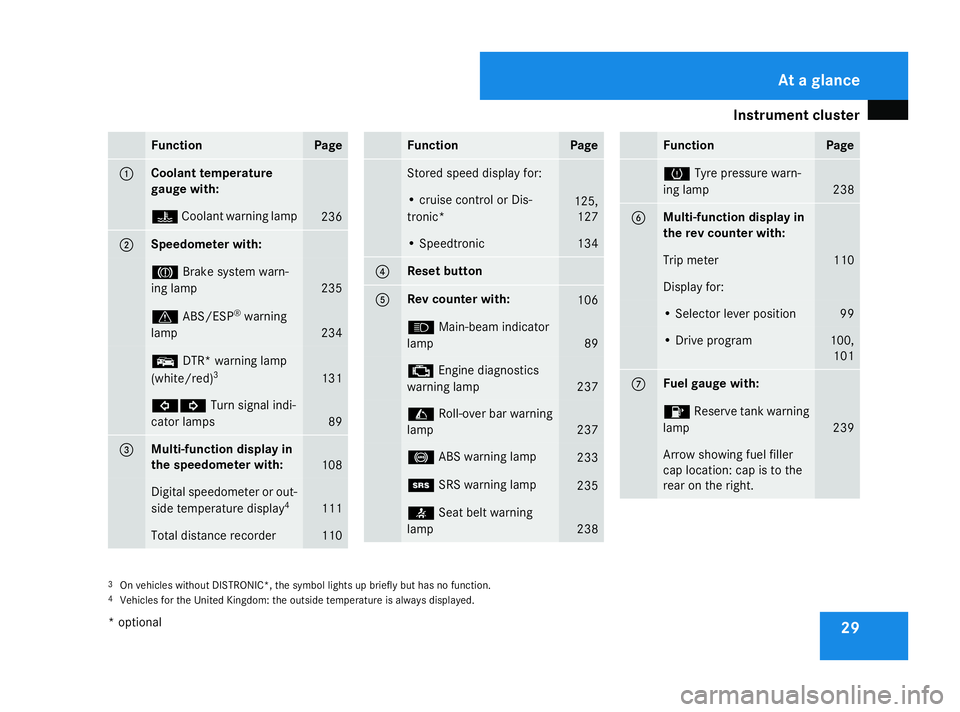
Instrument cluster
29Function Page
1 Coolant temperature
gauge with:
D
Coolant warnin glamp 236
2 Speedometer with:
3
Brake system warn-
in gl amp 235
v
ABS/ESP ®
warning
lamp 234
E
DTR* warnin glamp
(white/red) 3 131
LK
Turnsignal indi-
cator lamps 89
3 Multi-function display in
th
es peedometer with: 108
Digital speedometer or out-
side temperature display
4 111
Total distanc
erecorder 110 Function Page
Store
dspeed display for: •c
ruise control or Dis-
tronic* 125,
127 •S
peedtronic 134
4 Reset button
5 Rev counte
rwith: 106
A
Main-beam indicator
lamp 89
±
Enginediagnostics
warnin glamp 237
C
Roll-ove rbar warning
lamp 237
-
ABSw arnin glamp 233
1
SRS warnin glamp 235
<
Seat belt warning
lamp 238 Function Page
X
Tyre pressur ewarn-
in gl amp 238
6 Multi-function display in
th
er ev counte rwith: Tri
pm eter 110
Displa
yfor: •S
electo rlever position 99
•D
rive program 100,
101 7 Fuel gauge with:
4
Reserv etankw arning
lamp 239
Arrow showin
gfuelfiller
cap location :cap is to the
rear on th eright. 3
On vehicles without DISTRONIC* ,the symbol lights up briefl ybut has no function.
4 Vehicles fo rthe United Kingdom: th eoutsid etem perature is always displayed. At
ag lance
*o ptional
230_AKB; 5; 4, en-GB
bjanott
,V ersion: 2.9.6
2008-04-08T15:09:54+02:00
-Seite 29 Dateiname: 6515_3089_02_buchblock.pdf; preflight
Page 44 of 317
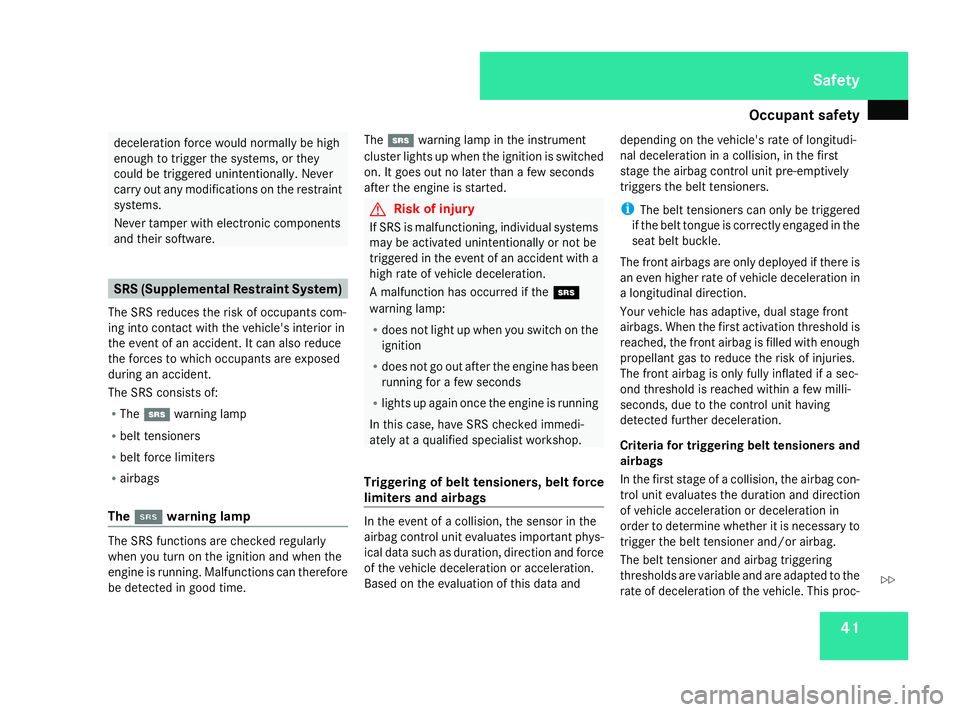
Occupant safety
41deceleration forc
ewould normally be high
enough to trigger the systems ,orthey
could be triggered unintentionally. Never
carry out any modifications on the restraint
systems.
Never tamper with electronic components
and their software. SRS (Supplementa
lRestraint System)
The SRS reduces the risk of occupants com-
ing int ocontact with the vehicle's interior in
the event of an accident. It can also reduce
the forces to which occupants are exposed
during an accident.
The SRS consists of:
R The 1 warning lamp
R belt tensioners
R belt forc elimiters
R airbags
The 1 1 warning lamp The SRS function
sare checked regularly
when you turn on the ignition and when the
engin eisrunning. Malfunctions can therefore
be detected in good time. The
1 warning lamp in the instrument
cluster lights up when the ignition is switched
on. It goes out no later than afew seconds
after the engin eisstarted. G
Risk of injury
If SRS is malfunctioning, individual systems
may be activated unintentionally or not be
triggered in the event of an acciden twith a
high rate of vehicle deceleration.
Am alfunction has occurred if the 1
warning lamp:
R does not light up when you switch on the
ignition
R does not go out after the engin ehas been
running for afew seconds
R lights up again onc ethe engin eisrunning
In this case, have SRS checked immedi-
ately at aqualified specialist workshop.
Triggering of belt tensioners, belt force
limiter sand airbags In the event of
acollision, the sensor in the
airbag control unit evaluates important phys-
ical data such as duration, direction and force
of the vehicle deceleration or acceleration.
Based on the evaluation of this data and depending on the vehicle's rate of longitudi-
nal deceleration in
acollision, in the first
stage the airbag control unit pre-emptively
trigger sthe belt tensioners.
i The belt tensioners can only be triggered
if the belt tongue is correctly engaged in the
seat belt buckle.
The fron tairbags are only deployed if ther eis
an even higher rate of vehicle deceleration in
al ongitudinal direction.
Your vehicle has adaptive, dual stage front
airbags. When the first activation threshold is
reached, the fron tairbag is filled with enough
propellant gas to reduce the risk of injuries.
The fron tairbag is only fully inflated if asec-
ond threshold is reached within afew milli-
seconds, due to the control unit having
detected further deceleration.
Criteria for triggering belt tensioners and
airbags
In the first stage of acollision, the airbag con-
trol unit evaluates the duration and direction
of vehicle acceleration or deceleration in
order to determine whether it is necessary to
trigger the belt tensioner and/or airbag.
The belt tensioner and airbag triggering
thresholds are variable and are adapted to the
rate of deceleration of the vehicle. This proc- Safety
230_AKB
;5;4,en-GB
bjanott, Version:2.9.6
2008-04-08T15:09:54+02:0
0-Seite 41 ZDateiname: 6515_3089_02_buchblock.pdf; preflight
Page 45 of 317
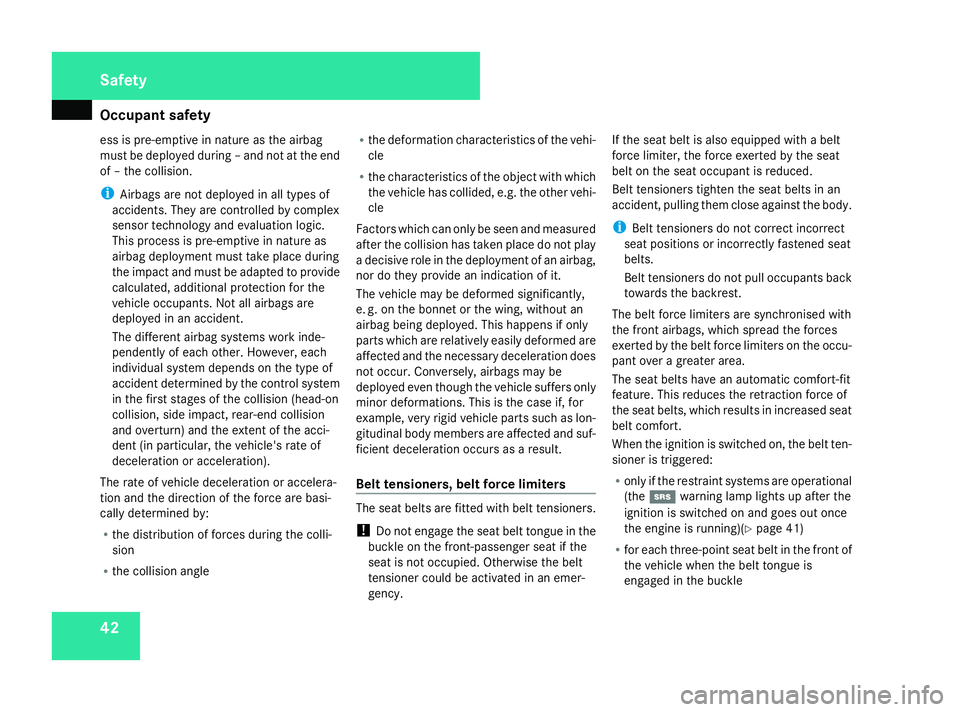
Occupant safety
42
ess is pre-emptive in nature as the airbag
must be deployed during –and not at the end
of –t he collision.
i Airbags are not deployed in all types of
accidents. They are controlled by complex
sensor technology and evaluation logic.
This proces sispre-emptive in nature as
airbag deployment must take place during
the impact and must be adapted to provide
calculated, additional protection for the
vehicle occupants. Not all airbags are
deployed in an accident.
The differen tairbag systems work inde-
pendently of each other .However, each
individual system depends on the type of
acciden tdetermined by the control system
in the first stages of the collision (head-on
collision, side impact ,rear-en dcollision
and overturn) and the extent of the acci-
dent (in particular, the vehicle's rate of
deceleration or acceleration).
The rate of vehicle deceleration or accelera-
tion and the direction of the forc eare basi-
cally determined by:
R the distribution of forces during the colli-
sion
R the collision angle R
the deformation characteristic softhe vehi-
cle
R the characteristic softhe objec twith which
the vehicle has collided, e.g. the other vehi-
cle
Factors which can only be seen and measured
after the collision has taken place do not play
ad ecisive role in the deployment of an airbag,
nor do they provide an indication of it.
The vehicle may be deformed significantly,
e. g. on the bonnet or the wing, without an
airbag being deployed. This happens if only
parts which are relatively easily deformed are
affected and the necessary deceleration does
not occur. Conversely, airbags may be
deployed even though the vehicle suffers only
minor deformations .This is the case if, for
example, very rigid vehicle parts such as lon-
gitudinal body members are affected and suf-
ficien tdeceleration occurs as aresult.
Belt tensioners, belt force limiters The seat belts are fitted with belt tensioners.
!
Do not engage the seat belt tongue in the
buckle on the front-passenger seat if the
seat is not occupied. Otherwise the belt
tensioner could be activated in an emer-
gency. If the seat belt is also equipped with
abelt
forc elimiter, the forc eexerted by the seat
belt on the seat occupant is reduced.
Belt tensioners tighten the seat belts in an
accident, pulling them close against the body.
i Belt tensioners do not correct incorrect
seat position sorincorrectly fastened seat
belts.
Belt tensioners do not pull occupants back
towards the backrest.
The belt forc elimiters are synchronised with
the fron tairbags, which spread the forces
exerted by the belt forc elimiters on the occu-
pant over agreater area.
The seat belts have an automatic comfort-fit
feature. This reduces the retraction forc eof
the seat belts, which results in increased seat
belt comfort.
When the ignition is switched on, the belt ten-
sioner is triggered:
R only if the restraint systems are operational
(the 1 warning lamp lights up after the
ignition is switched on and goes out once
the engin eisrunning)(Y page 41)
R for each three-poin tseat belt in the fron tof
the vehicle when the belt tongue is
engaged in the buckle Safety
230_AKB
;5;4,en-GB
bjanott, Version:2.9.6
2008-04-08T15:09:54+02:0
0-Seite 42 Dateiname: 6515_3089_02_buchblock.pdf; preflight